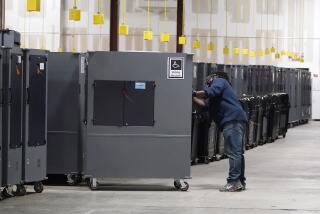More Discrepancies in Microsoft’s Video
- Share via
WASHINGTON — Embarrassed Microsoft Corp. officials ordered company engineers to redo a controversial software demonstration, after the government’s lead trial lawyer Wednesday uncovered more problems with the presentation.
In a second day of riveting courtroom drama, lead government lawyer David Boies got Microsoft Senior Vice President James Allchin to admit there was more than one computer used in Microsoft’s video demonstration. The video was intended as a reenactment of Allchin’s test of how Windows 98 is affected by removing its Internet Explorer Web browser.
Airing a four-minute video segment purporting to show a personal computer that had portions of the Web browser removed, Boies asked Allchin: “Is that one single machine or multiple machines slipping in and out” of the video?
Peering intently at a monitor displaying the video, Allchin initially responded, “I can’t tell.”
But then Boies zoomed in on an icon on the left-hand side of the screen that mysteriously disappeared during the software demonstration. “Where we had two icons, we just had one, you see that,” Boies thundered.
“Yes . . . but I still stand by my testing,” Allchin responded.
The 47-year-old executive later acknowledged that Microsoft had used several computers to conduct the tests, but pieced together the video in a way that suggests a single computer is being shown in the video demonstration.
Turning to presiding U.S. District Judge Thomas Penfield Jackson, Allchin asked for reconsideration after Boies had discredited the video: “Sir, can I bring in a machine and demonstrate [again]?”
But the damage had been done. And Allchin, who thought he had recovered by summoning a team of Microsoft technicians to Washington to vouch for the video after Boies first raised questions about it Tuesday, was again undermined by discrepancies in the presentation.
At the end of Wednesday’s trial session, Jackson turned to Allchin and said: “It’s very troubling, Mr. Allchin. I would feel much better if you made the test yourself.” Later, the judge added, “This certainly casts doubt on the reliability” of the videotape.
Microsoft plans to make another try today with a new taped demonstration.
Though produced by software engineers at one of the world’s richest and most technologically savvy companies, the 90-minute videotape underscores the riskiness of demonstrating the behavior of software.
Indeed, Microsoft Chairman Bill Gates himself was a victim of such a glitch last spring. While attempting to demonstrate a new feature in Windows 98 at the Comdex computer industry trade show in Chicago, Gates’ computer screen suddenly went blue and displayed a message well-known to Windows users: “Fatal Exception Error.”
The videotape snafu also spotlights the challenges Jackson will face in evaluating the various technical disputes that have arisen during the trial.
In the fall, for example, Apple Computer executive Avadis Tevanian testified on behalf of the government that Microsoft “sabotaged” his company’s QuickTime media player. But Microsoft pointed the finger at Apple, saying QuickTime’s inability to run reliably on Windows was due to poorly written Apple software code.
Microsoft had hoped to use the 90-minute video to demonstrate that its Internet Explorer browser could not be removed without impairing the operating system.
The issue of whether the browser is an integral part of Windows has become central in the antitrust trial.
Microsoft has claimed that including features such as Web browsers in an operating system is a common industry practice and benefits consumers.
But the government contends the integration is anti-competitive, because it forces consumers who buy one product to automatically take another. Under federal antitrust laws, the government maintains, a company is not permitted to leverage its dominance in one product area to achieve control of another.
More to Read
Sign up for Essential California
The most important California stories and recommendations in your inbox every morning.
You may occasionally receive promotional content from the Los Angeles Times.













